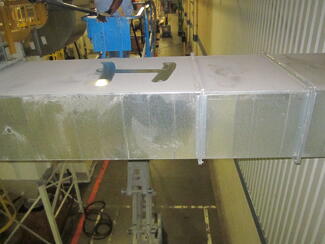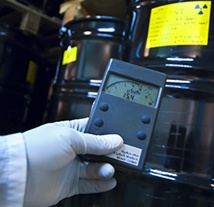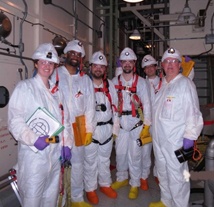By: Amy E. Theis, P.E.
Manager, Risk Management Services, Fauske & Associates, LLC
The National Fire Protection Association (NFPA) 654, Standard for the Prevention of Fire and Dust Explosions from the Manufacturing, Processing, and Handling of Combustible Particulate Solids, 2013 Edition applies to a variety of industries including, but not limited to, plastics, polymers, pharmaceuticals, consumer products and fine chemicals. This standard is typically applied to a facility to evaluate workplace conditions which could potentially lead to a fire or explosion due to a combustible dust hazard. Some of the items in this standard are retroactive requirements. These include elements of facility management, maintenance, documentation and training. Each of these areas should have a written policy and plan, auditable record keeping and any additional requirements identified. [NFPA 654, § 1.5]

Fugitive Dust, Courtesy Hughes Environmental
Retroactive Requirements for NFPA 654
• Management of Change [NFPA 654, §4.3.1]
• Housekeeping [NFPA 654, §8.2.1 - §8.2.3]
• Control of Ignition Sources [NFPA 654, §9.3.2, §9.3.3, §9.4.1-9.4.3, §9.5.1 - §9.5.3]
• Training [NFPA 654, §11.2 and §11.3]
• Inspection, Testing and Maintenance [NFPA 654, §12.1.1 - §12.1.3]
Management of Change (MOC)
A written Management of Change (MOC) program is required for proposed equipment and process changes to areas where combustible dust is handled. The written MOC program must establish a method for managing changes to process materials, technology, equipment, procedures and facilities. A safety review must be performed and documented to ensure that any hazards introduced to the process are addressed in an appropriate manner. Well structured MOC programs also include provisions to handle emergency changes that may arise. Elements of an MOC program must ensure that the following issues are addressed prior to any change:
• The technical basis for the proposed change
• The safety and health implications
• Whether the change is permanent or temporary
• Modifications to operating and maintenance procedures
• Employee training requirements
• Authorization requirements for the proposed change
Housekeeping
A written Housekeeping Program/Plan should include documented dust accumulation threshold, required cleaning frequencies, inspections, spill response and cleaning methods. [NFPA 654, §6.1, §8.2, and §11.2.2]
The basis of a Housekeeping Plan should include the following: [NFPA 654, §8.2.1 - §8.2.3]
• Housekeeping procedures
• Established time frames to respond to and accomplish spill clean-ups, or inappropriate accumulations of combustible dusts
• Documented risk evaluation to determine the level of housekeeping /protection measures
• Specify cleaning methods that minimize the risk of generating a fire or explosion hazard
• Portable vacuum cleaners meet Class II and are bonded and grounded
• If flammable vapors or gases are present, vacuum must be listed for both Class I and Class II
Control of Ignition Sources
Select ignition sources specify a retroactive requirement according to the most recent NFPA guidelines. These include the following sources.
• Static electricity requirements related to conductive components and bonding and grounding practices [NFPA 654, §9.3]
• Cartridge-actuated tools [NFPA 654, §9.4]
• Open flames and sparks such as hot work and smoking [NFPA 654, §9.5]
Note that provisions for other ignition sources are given in NFPA, but are not considered retroactive.
Training
Training, procedures and equipment attentive to mitigate fugitive dust are required to transfer combustible dusts into and out of processing equipment and to handle these materials safely (NFPA 654, §11.2). Site specific combustible dust training must be provided to employees, documented and include the following elements.
• Initial and refresher training shall be provided to employees who are involved in operating, maintaining and supervising facilities that handle combustible particulate solids.
• Initial and refresher training shall ensure that all employees are knowledgeable about the following:
- Hazards of their workplace
- General orientation, including plant safety rules
- Process description
- Equipment operation, safe startup and shutdown and response to upset conditions
- Equipment maintenance requirements and practices
- Housekeeping requirements
- Emergency response plans including prevention, preparation and response to work-related emergencies including but not limited to fire and explosion
• Employer certification and documentation of training
• Train operators on their process area/equipment and include training/updates on new safety procedures or explosion mitigation devices installed on relevant equipment
• Written operating and maintenance procedures including required personal protective equipment (PPE), such as flame resistant garments, in accordance with the workplace hazard assessment required by NFPA 2113, Standard on Selection, Care, Use, and Maintenance of Flame-Resistant Garments for Protection of Industrial Personnel Against Flash Fire
• Annual review of plans and procedures or, as required by process changes
• Contractor training including hazard awareness, procedures and plans as applicable
Inspection, Testing and Maintenance
A written inspection, testing and maintenance program is a retroactive requirement and is required to be developed and implemented to ensure that the fire and explosion protection systems and related process controls and equipment per form as designed.
The inspection, testing and maintenance program shall include the following:
• Fire and explosion protection and prevention equipment in accordance with NFPA standards
• Dust control equipment operates properly
• Housekeeping is effective
• Potential ignition sources are controlled
• Electrical, process, and mechanical equipment, including process interlocks are maintained
• Process changes are reviewed by a Management of Change Program
• Lubrication schedules are identified and maintained for bearings and other rotating equipment or components as necessary
• Records shall be kept of maintenance and repairs performed [NFPA 654, §12.1.3]
In addition, specific requirements exist for maintenance on the following pieces of equipment:
air-material separators and filter media, abort gates and dampers, fire and explosion protection systems, air-moving devices (i.e. fans and blowers), material feeding devices and bearings.
Process Hazard Analysis (PHA)
The process hazard analysis (PHA) requirement has been in effect since 2006 and affects facilities designed and built on or after this date. However, proposed modifications such as equipment replacement or changes will trigger the PHA requirement. The PHA must be conducted to address the fire and explosion safety provisions of the facility, equipment and processes when major replacements or renovations of an existing facility occur. [NFPA 654, §4.2.1] If the process, equipment, or operation does not prevent accumulation of dust external to equipment at all times, then the PHA must identify and document the maximum allowable layer thickness, maximum allowable deposit sur face area and minimum personal protective equipment (PPE) requirements. [NFPA 654, §4.2.3] The results of the process hazard analysis need to be documented and maintained for the life of the process. [NFPA 654, §4.2.2] While conducting a PHA is not a retroactive requirement for the existing facility, it can serve as a useful tool to evaluate risk of specific upset scenarios and determine if adequate safeguards and protective strategies are in place.
Conclusion
Each of these programs may already exist in a facility as part of their current safety program. However, it is important to evaluate these programs and verify that combustible dust hazards are adequately identified and addressed in each safety management system. Fauske & Associates, LLC can provide assistance in evaluating and updating these programs as needed to ensure that combustible dust hazards are properly identified and evaluated to determine if adequate protection is currently implemented.
For more information, please contact Amy Theis, 630-887-5211, theis@fauske.com









